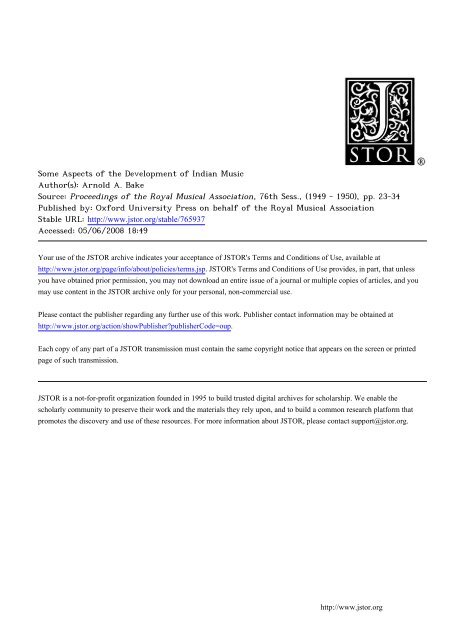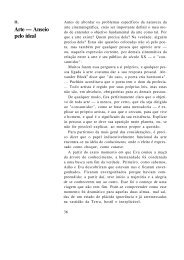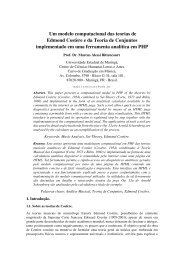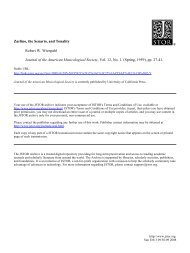Some Aspects of the Development of Indian Music Author(s ... - DMU
Some Aspects of the Development of Indian Music Author(s ... - DMU
Some Aspects of the Development of Indian Music Author(s ... - DMU
You also want an ePaper? Increase the reach of your titles
YUMPU automatically turns print PDFs into web optimized ePapers that Google loves.
<strong>Some</strong> <strong>Aspects</strong> <strong>of</strong> <strong>the</strong> <strong>Development</strong> <strong>of</strong> <strong>Indian</strong> <strong>Music</strong><strong>Author</strong>(s): Arnold A. BakeSource: Proceedings <strong>of</strong> <strong>the</strong> Royal <strong>Music</strong>al Association, 76th Sess., (1949 - 1950), pp. 23-34Published by: Oxford University Press on behalf <strong>of</strong> <strong>the</strong> Royal <strong>Music</strong>al AssociationStable URL: http://www.jstor.org/stable/765937Accessed: 05/06/2008 18:49Your use <strong>of</strong> <strong>the</strong> JSTOR archive indicates your acceptance <strong>of</strong> JSTOR's Terms and Conditions <strong>of</strong> Use, available athttp://www.jstor.org/page/info/about/policies/terms.jsp. JSTOR's Terms and Conditions <strong>of</strong> Use provides, in part, that unlessyou have obtained prior permission, you may not download an entire issue <strong>of</strong> a journal or multiple copies <strong>of</strong> articles, and youmay use content in <strong>the</strong> JSTOR archive only for your personal, non-commercial use.Please contact <strong>the</strong> publisher regarding any fur<strong>the</strong>r use <strong>of</strong> this work. Publisher contact information may be obtained athttp://www.jstor.org/action/showPublisher?publisherCode=oup.Each copy <strong>of</strong> any part <strong>of</strong> a JSTOR transmission must contain <strong>the</strong> same copyright notice that appears on <strong>the</strong> screen or printedpage <strong>of</strong> such transmission.JSTOR is a not-for-pr<strong>of</strong>it organization founded in 1995 to build trusted digital archives for scholarship. We enable <strong>the</strong>scholarly community to preserve <strong>the</strong>ir work and <strong>the</strong> materials <strong>the</strong>y rely upon, and to build a common research platform thatpromotes <strong>the</strong> discovery and use <strong>of</strong> <strong>the</strong>se resources. For more information about JSTOR, please contact support@jstor.org.http://www.jstor.org
9 February, 1950W. GREENHOUSE ALLT, ESQ., Mus.D., F.T.C.L., F.R.C.OVICE-PRESIDENT,IN THE CHAIR.SOME ASPECTS OF THE DEVELOPMENT OFINDIAN MUSIC.BY ARNOLD A. BAKE, M.A., D.LITr.Owing to printer's difficulties <strong>the</strong> cerebral consonants, <strong>the</strong> visarga, <strong>the</strong>sonant r and <strong>the</strong> anusvdra have remained unmarked.IT is now very close upon two hundred years since <strong>Indian</strong>culture as such first struck scholars from <strong>the</strong> West and <strong>the</strong>momentous discovery <strong>of</strong> <strong>the</strong> language <strong>of</strong> Sanskrit opened<strong>the</strong> way for a completely new branch <strong>of</strong> studies-that <strong>of</strong>comparative philology.It was most fortunate that among <strong>the</strong> very first to enter<strong>the</strong> field was a man <strong>of</strong> such keen artistic perception andsensitiveness as Sir William Jones. His wide range <strong>of</strong>interest covered more than philology alone and it is to himthat we owe one <strong>of</strong> <strong>the</strong> first treatises on <strong>Indian</strong> music, On <strong>the</strong><strong>Music</strong>al Modes <strong>of</strong> <strong>the</strong> Hindus, written as early as 1784, fromwhich we can learn a good deal, even now.It is remarkable to find in Sir William Jones's article such astrong and reasoned perception <strong>of</strong> <strong>the</strong> affinity <strong>of</strong> <strong>the</strong> <strong>Indian</strong>musical system with that <strong>of</strong> <strong>the</strong> West. This is indeed afeature that we should never forget. It cannot be repeated<strong>of</strong>ten enough that in <strong>the</strong> field with which we are dealing here,<strong>the</strong> dividing line between East and West lies to <strong>the</strong> east <strong>of</strong><strong>the</strong> <strong>Indian</strong> Peninsula and runs through Assam and Burma,not to <strong>the</strong> west <strong>of</strong> that Subcontinent.Let us have a look at <strong>the</strong> finished system which confrontedSir William Jones. In <strong>the</strong> eighteenth century <strong>Indian</strong> musicwas long past its prime and one may surmise that some decayhad already set in-at least in North India-with <strong>the</strong> generaldecline <strong>of</strong> culture under <strong>the</strong> successors <strong>of</strong> Aurangzeb. Themost striking feature <strong>of</strong> <strong>the</strong> music was <strong>the</strong> minutely regulatedRdga-system, hundreds <strong>of</strong> rdgas, each one creating a specialatmosphere through its own particular musical features andcharacteristics, individualized and depicted in poetry andpainting. Sir William Jones recognized <strong>the</strong>m for what <strong>the</strong>ywere, developments and refinements <strong>of</strong> a set <strong>of</strong> primary modes.
24<strong>Development</strong> <strong>of</strong> <strong>Indian</strong> <strong>Music</strong>He says (Hindu music from various authors, by SourendroMohun Tagore, pp. 130-131):'The longer intervals we shall call tones, and <strong>the</strong> shorter (in compliancewith custom) semitones, without mentioning <strong>the</strong>ir exact ratios; and it isevident that, as <strong>the</strong> places <strong>of</strong> <strong>the</strong> semitones admit seven variations relativeto one fundamental sound, <strong>the</strong>re are as many modes which may be calledprimary; but we must not confound <strong>the</strong>m with our modem modes, whichresult from <strong>the</strong> system <strong>of</strong> accords now established in Europe; <strong>the</strong>y mayra<strong>the</strong>r be compared with those <strong>of</strong> <strong>the</strong> Roman Church, where some valuableremnants <strong>of</strong> old Grecian music are preserved in <strong>the</strong> sweet, majestic, simpleand affecting strains <strong>of</strong> <strong>the</strong> Plain Song.'It is a fact that <strong>the</strong> primary <strong>Indian</strong> modes, <strong>the</strong>jdtis mentionedin <strong>the</strong> oldest treatise, <strong>the</strong> Bharatandtyafdstra and in <strong>the</strong> laterSangttaratndkara, are formed in precisely <strong>the</strong> same way as ourGregorian modes, namely by taking <strong>the</strong> notes <strong>of</strong> a basic scaleone by one as <strong>the</strong> starting point <strong>of</strong> a new, subsequent mode.Thus <strong>the</strong> first jdti <strong>of</strong> <strong>the</strong> <strong>Indian</strong> system is that basic series itself,<strong>the</strong> second an octave scale starting from <strong>the</strong> second note andcalled drsabhi after this second note, rsabha, <strong>the</strong> third, Gdndhdriafter <strong>the</strong> third note Gdndhara, and so on.We also find express mention <strong>of</strong> <strong>the</strong> fact that all <strong>the</strong>semodes can be started from one and <strong>the</strong> same note, namely<strong>the</strong> first <strong>of</strong> <strong>the</strong> basic series, provided that <strong>the</strong> internal arrangement<strong>of</strong> tones and semitones is not upset by that process.The accidentals arising from this procedure are consequently<strong>the</strong> same as in our system, flats for <strong>the</strong> second, <strong>the</strong> third,<strong>the</strong> sixth and <strong>the</strong> seventh note, and a sharp for <strong>the</strong> fourth,which appears in <strong>the</strong> basic scale when <strong>the</strong> mode originallystarting on <strong>the</strong> fourth note is tratsposed to it. To take aWestern example, if <strong>the</strong> basic scale runs from C-c, <strong>the</strong> F-fscale,our mediaeval Lydian mode, will have an F sharpwhen transposed to C.Each <strong>of</strong> <strong>the</strong>se jdtis can <strong>the</strong>n be fur<strong>the</strong>r developed and definedand, according to <strong>the</strong> characteristics on which <strong>the</strong> attentionis focussed, become <strong>the</strong> mo<strong>the</strong>r <strong>of</strong> several rdgas. The object<strong>of</strong> each Rdga is to exemplify a certain mood or emotionalcolouring, illustrated or engendered by <strong>the</strong> prominent characteristics<strong>of</strong> <strong>the</strong> special sequence <strong>of</strong> notes.Sir William Jones's comparison <strong>of</strong> <strong>the</strong> Gregorian modeswith those basic jatis is consequently very pertinent and Ishould like to give you an example <strong>of</strong> one <strong>of</strong> <strong>the</strong>m first in plainchantand <strong>the</strong>n in <strong>the</strong> form it has taken in modern South<strong>Indian</strong> music. It is <strong>the</strong> mediaeval Dorian (<strong>the</strong> Greek Phrygic)mode, from D-d, or with two flats when taken from C. InSouth India this mode bears <strong>the</strong> name <strong>of</strong> Karaharapriyaand in <strong>the</strong> North it is called Kafi. It is sung by Mr. John Marr,
...l<strong>Development</strong> <strong>of</strong> <strong>Indian</strong> <strong>Music</strong>25one <strong>of</strong> <strong>the</strong> students <strong>of</strong> <strong>the</strong> S.O.A.S., who has made a veryspecial study <strong>of</strong> South-<strong>Indian</strong> music and has grown up in <strong>the</strong>Gregorian practice.Examples: Gramophone Records.This sameness <strong>of</strong> <strong>the</strong> modes and <strong>the</strong> jatis presupposessameness <strong>of</strong> primary musical conception and indeed wedo find <strong>the</strong> <strong>Indian</strong> system also based on <strong>the</strong> recognition <strong>of</strong>absolute consonance, implied in <strong>the</strong> first and second partial,namely <strong>the</strong> absolute consonance <strong>of</strong> <strong>the</strong> octave, <strong>the</strong> fifthand its inversion <strong>the</strong> fourth. The ancient <strong>Indian</strong> systemrecognizes three octaves or registers: <strong>the</strong> lowest, called lowor heart register; <strong>the</strong> second, middle or throat register; <strong>the</strong>third, high or head register. The seven notes in each successiveoctave are <strong>the</strong> repetition <strong>of</strong> those <strong>of</strong> <strong>the</strong> previous one.So we see that <strong>the</strong> multitude <strong>of</strong> rdgas can be reduced to sevenjdtis, or primary modes and that <strong>the</strong> primary modes are builtup out <strong>of</strong> seven notes or svaras. These svaras are <strong>of</strong> unequalsize as indicated by <strong>the</strong> number <strong>of</strong> frutis or microtones <strong>the</strong>ycomprise. The equivalent <strong>of</strong> our major tone has four,<strong>the</strong> equivalent <strong>of</strong> our minor tone has three, <strong>the</strong> semi-tone twoqrutis. There are three major, two minor and two semitoneswithin <strong>the</strong> compass <strong>of</strong> an octave which gives <strong>the</strong> totalamount <strong>of</strong> twenty-two frutis. The series starts with a majortone called sa, <strong>the</strong>n follows a minor tone ri, <strong>the</strong>n a semi-tonega, <strong>the</strong>n a major tone ma, a major tone pa, a minor tone dha,and lastly a semitone ni.X 2 3 4 5 6 7 8 9 0o 2x 12 13 14 15 I6 x7 x8 19 20 2 2 2l l l I l l i l l l l lThe twenty-two frutis <strong>of</strong> <strong>the</strong> <strong>Indian</strong> Octave.This division <strong>of</strong> <strong>the</strong> octave into twenty-two ?rutis is <strong>the</strong>first major deviation from <strong>the</strong> system we follow. Naturallyit is this which has attracted most attention, and <strong>the</strong> discussionas to what size those Crut.s are has raged for more than acentury. Sir William Jones says on this point: (I. c. p. 135):'Let us proceed to <strong>the</strong> <strong>Indian</strong> system which is minutely explained in agreat number <strong>of</strong> Sanscrit books by authors who leave arithmetic andgeometry to <strong>the</strong>ir astronomers and properly discourse music as an artconfined to <strong>the</strong> pleasures <strong>of</strong> imagination.'In <strong>the</strong> heat <strong>of</strong> <strong>the</strong> discussion <strong>of</strong> <strong>the</strong> exact nature <strong>of</strong> <strong>the</strong>frutis this has <strong>of</strong>ten been lost sight <strong>of</strong>. The essence andraison d'etre <strong>of</strong> music, from <strong>the</strong> <strong>Indian</strong> point <strong>of</strong> view, is
<strong>Development</strong> <strong>of</strong> <strong>Indian</strong> <strong>Music</strong>27Sir William Jones asked <strong>the</strong> same question and he reports(pp. 141-142):'I tried in vain to discover any difference in practice between <strong>the</strong> <strong>Indian</strong>scale and our own; but, knowing my ear to be very insufficiently exercised,I requested a German pr<strong>of</strong>essor <strong>of</strong> music to accompany with his violina Hindu lutenist, who sang by note some popular airs on <strong>the</strong> loves <strong>of</strong>Crishna and Radha; he assures me that <strong>the</strong> scales were <strong>the</strong> same.'From <strong>the</strong>se premises and with <strong>the</strong> scheme <strong>of</strong> <strong>the</strong> sa-grdmain front <strong>of</strong> him, he <strong>the</strong>n proceeded to identify <strong>the</strong> notes <strong>of</strong>this scale with ours and arrived at <strong>the</strong> conclusion that itcorresponded 'pretty nearly to our major mode: Ut re mifa sol la si ut.' (p. 142).1l SA RI GA MA PA )1AI1111 1111 11 111 lll I 111 11vI 1i lIIL13A. M SoLRI v GLl1iill I I lll ii i 1111 111111If we accept this statement, which was plainly corroboratedby <strong>the</strong> actual practice <strong>of</strong> his day, and turn to <strong>the</strong> ma-grdmastarting from <strong>the</strong> fourth, we see that that gives a scale withan augmented fourth, in o<strong>the</strong>r words a scale starting with atritone, an interval abhorred in <strong>the</strong> West but very popularin India. Indeed, taken in <strong>the</strong> sense in which Sir William tookit, <strong>the</strong> two grdmas would be <strong>the</strong> basis <strong>of</strong> <strong>the</strong> moder South<strong>Indian</strong> melakarta system in which thirty-six out <strong>of</strong> <strong>the</strong> total <strong>of</strong>seventy-two basic rdgas have a perfect fourth, and thirtysixan augmented fourth.There are, however, indications that, whatever <strong>the</strong> currentpractice was in <strong>the</strong> eighteenth century, it certainly did notrepresent <strong>the</strong> practice <strong>of</strong> <strong>the</strong> days when this system was inventedor formulated. For one thing <strong>the</strong>re would have been no sensein calling that one fruti which changes <strong>the</strong> relative size <strong>of</strong> <strong>the</strong>fifth and sixth note '<strong>the</strong> indicative ?ruti,' because <strong>the</strong> augmentedfourth would be <strong>the</strong> same even if <strong>the</strong> ma-grdma were taken as amurchand <strong>of</strong> <strong>the</strong> sa-grdma. The character <strong>of</strong> <strong>the</strong> tritone is notmaterially affected by <strong>the</strong> middle notes changing from amajor and a minor to a minor and a major tone respectively.But apart from that fact <strong>the</strong>re is ano<strong>the</strong>r and much morecompelling reason to reject this interpretation <strong>of</strong> <strong>the</strong> sa-gramaas a counterpart <strong>of</strong> our major mode. All <strong>the</strong> treatisesincluding<strong>the</strong> Rdgavibodha, a seventeenth century work,which was known to Sir William-lay down <strong>the</strong> rule that <strong>the</strong>
I28<strong>Development</strong> <strong>of</strong> <strong>Indian</strong> <strong>Music</strong>notes were realized at <strong>the</strong> end <strong>of</strong> <strong>the</strong>ir constituent frutis, sothat <strong>the</strong> picture <strong>of</strong> <strong>the</strong> sa-grdma and <strong>the</strong> ma-grdma reallylooks as you see it on this second chart, with <strong>the</strong> interval <strong>of</strong>four frutis between ni and sa and not between sa and ri.It consequently represents <strong>the</strong> mode from D-d, <strong>the</strong> mediaevalDorian, which you heard a few minutes ago. The ma-grdma,<strong>the</strong>n, is <strong>the</strong> mediaeval Mixolydian, (or Greek Hypophrygic)from G-g, and <strong>the</strong> ancestor <strong>of</strong> <strong>the</strong> South <strong>Indian</strong> Rdga Harikambojiand <strong>the</strong> North <strong>Indian</strong> Jhinjoti.Vi 4 ,lu ( ^ MA IM 1A NU1111111111 11 11111111, 111 11 1
30<strong>Development</strong> <strong>of</strong> <strong>Indian</strong> <strong>Music</strong>plain words is <strong>the</strong> oldest treatise extant, <strong>the</strong> aforementionedBharatandtycdstra, which probably goes back to <strong>the</strong> 2ndcentury B.C. but represents an already fully developed musicalsystem with a fixed set <strong>of</strong> technical terms, which must havetaken centuries to crystalize.Excuse me for quoting one sentence in Sanskrit, because it is<strong>the</strong>se words which contain <strong>the</strong> whole explanation. Bharatasays (chapter 28, <strong>the</strong> prose after sloka 22) : : 'in <strong>the</strong> madhyamagrama<strong>the</strong> pa has to be tuned one fruti down' and<strong>the</strong>n continues 'paicamasya 9rutyutkarsapakarsabhyam yadantaram mardavad ayatatvad va tavad pramn?agrutih.Which means: <strong>the</strong> interval which results from <strong>the</strong> tuning upor down <strong>of</strong> that ?ruti <strong>of</strong> <strong>the</strong> pancama (up from ma to sa-grama,down from sa- to ma-grdma) is called <strong>the</strong> "indicative ?ruti"by reason <strong>of</strong> <strong>the</strong> resulting state <strong>of</strong> mrdu or dyata.'So we see that <strong>the</strong> question <strong>of</strong> size did not enter into <strong>the</strong>speculations <strong>of</strong> Bharata at all. The reason why that frutiwas called "indicative" was that it engendered a certain state,'mrdu' in <strong>the</strong> sa-grdma and 'dyata' in <strong>the</strong> ma-grdma. Youwill agree with me that everything now depends on <strong>the</strong> correcttranslation <strong>of</strong> <strong>the</strong>se two terms. Joanny Grosset, who translatedthis 28th chapter in 1888 in a booklet entitled Contributiond I'Etude de la Musique Hindoue put it (p. 57)L'intervalle d'une cruti qui represente 1'61evation ou l'abaissement depancama, sa diminution (mdrdava) ou son augmentation (dyatatva),est la gruti-type, indicatrice (pramdna." (<strong>the</strong> interval that represents <strong>the</strong>raising or lowering <strong>of</strong> <strong>the</strong> pancama, its diminution (mdrdava) or its augmentation(dyatatva) is <strong>the</strong> indicative pramana cruti).This is incorrect because <strong>the</strong> Sanskrit says: represents <strong>the</strong>indicative 9ruti on account <strong>of</strong> its mdrdava or dyatatva, using<strong>the</strong> ablative case.Fox Strangways does not mention this sentence, but wefind it again in Danielou, who translates it as follows (p. 116):'In <strong>the</strong> magrdma <strong>the</strong> pancama must be lowered by one sruti. The difference<strong>of</strong> pancama is <strong>the</strong> very measure <strong>of</strong> crutis (which can be described as adifference <strong>of</strong>) s<strong>of</strong>tness or accentuations, <strong>of</strong> expression or <strong>of</strong> length.'It is presumably on this passage that he builds his laterassertion that Bharata, <strong>of</strong> <strong>the</strong> second century B.C. in commonwith Ahobala <strong>of</strong> <strong>the</strong> eighteenth century, knew <strong>the</strong> definition<strong>of</strong> pitch by length <strong>of</strong> string (p. 130).Now it is quite clear that mdrdava and dyatatva are designations<strong>of</strong> two different states. The former is derived from <strong>the</strong>word mrdu, which means s<strong>of</strong>t, and can thus be translated bys<strong>of</strong>tness. The o<strong>the</strong>r is derived from <strong>the</strong> word dyata, which
<strong>Development</strong> <strong>of</strong> <strong>Indian</strong> <strong>Music</strong>means extended, but is also used <strong>of</strong> <strong>the</strong> string <strong>of</strong> a bow when itis strung. As description <strong>of</strong> a condition, dyatatva can thusbe rendered by tautness or tenseness.Have <strong>the</strong>se terms really any connection with <strong>Indian</strong> musicalconceptions ? Bharata does not explain <strong>the</strong>m in <strong>the</strong> course<strong>of</strong> his chapters on music, as he takes <strong>the</strong>m for granted. It isin <strong>the</strong> Sangitaratndkara <strong>of</strong> <strong>the</strong> twelfth century, that we find<strong>the</strong>m again in a suitably illuminating context. In <strong>the</strong> firstchapter <strong>of</strong> that book (I. 3.29) we find <strong>the</strong> statement that aFruti can be one <strong>of</strong> five things, according to <strong>the</strong> effect it produces.It can be mrdu-s<strong>of</strong>t, dipta-burning, karunapitiableor compassionate, dyata, taut or tense, and finallymadhyama, middling or neutral.This is clearly <strong>the</strong> set <strong>of</strong> categories Bharata refers to. The?ruti in question is called indicative on account <strong>of</strong> <strong>the</strong> s<strong>of</strong>tness(in <strong>the</strong> sa-grama) and <strong>the</strong> tenseness (in <strong>the</strong> ma-grdma) resultingfrom its being shifted.Now, if you look at <strong>the</strong> scheme again, remembering that<strong>the</strong> sa-grdma starts on sa and <strong>the</strong> ma-grdma on ma, youwill see that <strong>the</strong> only difference between <strong>the</strong> two is, that <strong>the</strong>sa-grdma starts with a minor and <strong>the</strong> ma-grdma with a majorthird.One could raise <strong>the</strong> same objection as before, namely that itreally does not affect <strong>the</strong> actual size <strong>of</strong> <strong>the</strong> interval whe<strong>the</strong>r <strong>the</strong>pramana fruti belongs to pa or dha, <strong>the</strong> total number <strong>of</strong>Vrutis remaining <strong>the</strong> same in ei<strong>the</strong>r case.But, supposing <strong>the</strong> ma-grdma was taken as a mtirchand <strong>of</strong><strong>the</strong> sa-grdma, it <strong>the</strong>n would have a major third composed <strong>of</strong> amajor tone and a minor tone to contrast against <strong>the</strong> minorthird <strong>of</strong> <strong>the</strong> sa-grdma consisting <strong>of</strong> a minor tone and a semitone.This certainly would <strong>of</strong>fer a certain kind <strong>of</strong> contrastbut a ra<strong>the</strong>r mild one. If, however, one shifts <strong>the</strong> pramdnacruti as is indicated for <strong>the</strong> ma-grdma, from <strong>the</strong> end <strong>of</strong> pato <strong>the</strong> beginning <strong>of</strong> dha, <strong>the</strong> sequence <strong>of</strong> notes in both gramasbegins with a minor tone (ri in <strong>the</strong> sa-grdma and pa in <strong>the</strong>ma-grdma) after which <strong>the</strong> semitone, ga, <strong>of</strong> <strong>the</strong> sa-grdma,stands against <strong>the</strong> major tone, dha <strong>of</strong> <strong>the</strong> ma-grdma, whichis <strong>the</strong> strongest possible contrast admissible in this system.Consequently <strong>the</strong> pramdna-?ruti is indeed indicative <strong>of</strong> twodifferent tone-characters, mrdu, s<strong>of</strong>t in <strong>the</strong> sa-grdma with <strong>the</strong>minor third, and dyata, tense or taut in <strong>the</strong> ma-grdma with <strong>the</strong>major third.This approach from <strong>the</strong> angle <strong>of</strong> emotional effect is entirelyin accordance with <strong>the</strong> general attitude <strong>of</strong> <strong>the</strong> ancient <strong>Indian</strong>musicians towards <strong>the</strong>ir subject. What matters is what one31
32<strong>Development</strong> <strong>of</strong> <strong>Indian</strong> <strong>Music</strong>hears and how this affects <strong>the</strong> soul. The emotional effectis what determines <strong>the</strong> musical value. Hence Sir WilliamJones hit <strong>the</strong> nail on <strong>the</strong> head when he spoke <strong>of</strong>:'<strong>the</strong> authors who leave arithmetic and geometry to <strong>the</strong>ir astromonersand properly discourse on music and an art confined to <strong>the</strong> pleasures <strong>of</strong>imagination.'I do not want to say that those who start calculating andcyphering do not <strong>the</strong>reby discover valuable and correct data,but I do want to say that this ma<strong>the</strong>matical aspect <strong>of</strong> musicwas not present in <strong>the</strong> mind <strong>of</strong> Bharata when he defined <strong>the</strong>pramdna-qruti which was destined to become <strong>the</strong> startingpoint <strong>of</strong> elaborate ma<strong>the</strong>matical processes in <strong>the</strong> West sometwo thousand years after his death.By this I do not wish to imply that <strong>the</strong> <strong>Indian</strong>s <strong>the</strong>mselveshave never subjected <strong>the</strong>ir musical system to ma<strong>the</strong>maticalanalysis. Later writers, especially those from <strong>the</strong> seventeenthcentury onwards, like Ahobala, certainly have done so with avengeance, but although <strong>the</strong>y pr<strong>of</strong>ess to base <strong>the</strong>mselves onBharata, that author himself,-whoever he may have beenand whatever knowledge <strong>of</strong> <strong>the</strong> underlying ma<strong>the</strong>maticallaws he may have possessed-never made that a point in histreatise. He is severely practical and treats music as a part<strong>of</strong> <strong>the</strong> greater unity <strong>of</strong> <strong>the</strong>atrical arts, where <strong>the</strong> aim was <strong>the</strong>intimate emotional interplay between <strong>the</strong> actors and <strong>the</strong>iraudience, <strong>the</strong> creation <strong>of</strong> definite emotional states and conditionsin <strong>the</strong> souls <strong>of</strong> <strong>the</strong> spectators. It is this art and notma<strong>the</strong>matics which he pursues.It will be worth while to see what-if anything-has remained<strong>of</strong> this basic difference between <strong>the</strong> sa and <strong>the</strong> magrama,namely <strong>the</strong> initial minor and major thirds, in <strong>the</strong>modem rdgas that have developed from that basis. If <strong>the</strong>reis any truth in my contention, <strong>the</strong> Karaharapriya, <strong>the</strong> modemdescendent <strong>of</strong> <strong>the</strong> sa-grdma ought to stress <strong>the</strong> minor third,Jhinjoti, <strong>the</strong> <strong>of</strong>fspring <strong>of</strong> <strong>the</strong> ma-grdma <strong>the</strong> major third.Through <strong>the</strong> kindness <strong>of</strong> one <strong>of</strong> my <strong>Indian</strong> friends I havebeen able to secure an instance <strong>of</strong> each <strong>of</strong> <strong>the</strong>m sung by <strong>the</strong>same artist, an extremely accomplished singer, Khan SahibAbdul Karim Khan who, alas, is not alive any more. Theadvantage <strong>of</strong> having <strong>the</strong> two sung by <strong>the</strong> same man is that hestarts <strong>the</strong> ragas from <strong>the</strong> same tonic, or ra<strong>the</strong>r, that he sings<strong>the</strong>m against <strong>the</strong> same drone. Thereby it is possible to compare<strong>the</strong> two. <strong>Indian</strong> music does not recognize absolute orfixed pitch. It is severely modal and, as long as <strong>the</strong> internalarrangement <strong>of</strong> tones and semitones is not upset, one can starta raga from any pitch. So each singer chooses his (or her)
<strong>Development</strong> <strong>of</strong> <strong>Indian</strong> <strong>Music</strong>33pitch to suit his own voice. The drone never changes, nei<strong>the</strong>ron <strong>the</strong> drum nor on <strong>the</strong> accompanying tambura as long as <strong>the</strong>same singer performs, whatever <strong>the</strong> succession <strong>of</strong> rdgasperformed. If two singers follow one ano<strong>the</strong>r, <strong>the</strong> secondwill bring his own set <strong>of</strong> accompanying instruments, tamburaand drums mostly, in order to avoid lengthy and laboriousretuning. If <strong>the</strong> unspeakable harmonium is <strong>the</strong>re (as is <strong>the</strong>case in <strong>the</strong>se records) <strong>the</strong> drone can be changed without moreado.I will play <strong>the</strong> two records immediately after one ano<strong>the</strong>r,and you will hear how <strong>the</strong> first starts with <strong>the</strong> minor third andcontinually stresses that interval, whereas <strong>the</strong> second openswith <strong>the</strong> major third and brings it in again and again in <strong>the</strong>course <strong>of</strong> <strong>the</strong> melody.Example : Karaharapriya and Jhinjoti ---To show you how vividly <strong>the</strong> emotional effect <strong>of</strong> <strong>the</strong> interplay<strong>of</strong> <strong>the</strong> major and minor third is realized, I shall concludewith a short record by <strong>the</strong> same singer, in a rdga called Sindh-Kafi, which, as its name shows, is reckoned to belong to <strong>the</strong>Kafi class and consequently should have a minor third and aflat seventh all through. Here, however, <strong>the</strong> natural thirdand<strong>the</strong> natural seventh-are flashed into <strong>the</strong> picture againand again, and I don't think I could give a better illustration<strong>of</strong> mdrdava and dyatatva combined in <strong>the</strong> same melody.Example: Sindh-Kafi-When looking at <strong>Indian</strong> music, we may start calculating andcyphering to our heart's content, but we should never forgetthat <strong>the</strong> primary aim <strong>of</strong> <strong>the</strong> whole system, frutis, svaras,gramas, jdtis, rdgas and all, was from <strong>the</strong> beginning and stillis, rakti, musical charm.As Damodara says in his Mirror <strong>of</strong> <strong>Music</strong>-as late as <strong>the</strong>seventeenth century:Gitavaditranrtyanam raktih sadharano gunahato raktivihinam yan na tat sangitam ucyate (1. 6-7).'Rakti is <strong>the</strong> common quality <strong>of</strong> vocal music, instrumentalmusic and dance alike. Hence that which is devoid <strong>of</strong> rakticannot be called music.'
34<strong>Development</strong> <strong>of</strong> <strong>Indian</strong> <strong>Music</strong>APPENDIXContinuing his exposition <strong>of</strong> <strong>the</strong> notes and <strong>the</strong> grimas,Bharata mentions <strong>the</strong> phenomena <strong>of</strong> "kskali" and "antara,"accidentals affecting ni and ga respectively. (Bharatanatyaiastra28, verse 32 and following prose). With regard to <strong>the</strong>antarasvara, he gives an explanation in which he uses"mardava" as a technical term, but applies it to dha. In <strong>the</strong>passage quoted in <strong>the</strong> lecture, mirdava referred to pa onlyand denoted <strong>the</strong> change back from <strong>the</strong> ma to <strong>the</strong> sa grama,when <strong>the</strong> pa became a note <strong>of</strong> four qrutis again. Evidentlymardava henceforth denotes <strong>the</strong> process by which a noteacquires four srutis.He says (page 320 <strong>of</strong> <strong>the</strong> Benares edition <strong>of</strong> <strong>the</strong> text):"One murchana (viz. <strong>the</strong> first in <strong>the</strong> sa-grima, starting onsa) can be made tw<strong>of</strong>old (viz. belonging to both gramas) in<strong>the</strong> following way: when <strong>the</strong> ga is made like <strong>the</strong> dha (in <strong>the</strong>ma-grama) by <strong>the</strong> shift <strong>of</strong> two qrutis, <strong>the</strong> murchana comes tobelong to <strong>the</strong> o<strong>the</strong>r <strong>of</strong> <strong>the</strong> two gramas (gramyayor-readgrimayor-anyataratvam). In consequence ma and <strong>the</strong>following notes assume <strong>the</strong> function <strong>of</strong> ni and <strong>the</strong> followingnotes in regular order in <strong>the</strong> madhyamagrama. This tw<strong>of</strong>oldnessis due to <strong>the</strong> dha's being subject to mardava and to <strong>the</strong>fact that all <strong>the</strong> o<strong>the</strong>r notes have <strong>the</strong> same number <strong>of</strong> qrutis(in both grimas). By <strong>the</strong> raising <strong>of</strong> ga by two 9rutis a four9ruti note is created, with <strong>the</strong> same effect as what happens with<strong>the</strong> one-qrutinterval between pa and dha (viz. <strong>the</strong> change <strong>of</strong>grama). The o<strong>the</strong>r notes however, ma and so on, remainwhat <strong>the</strong>y were, as <strong>the</strong>y have <strong>the</strong> same number <strong>of</strong> rrutis ..."What actually happens is, that, if one wants to play <strong>the</strong>ma-grama starting from sa, one changes <strong>the</strong> minor third intoa major one, by making ga into a major tone, raising it bytwo grutis. This produces <strong>the</strong> same effect as playing <strong>the</strong> magramafrom ma with <strong>the</strong> dha as a four-$ruti note. Consequently<strong>the</strong> crucial difference between <strong>the</strong> two gramas is this differencebetween <strong>the</strong> minor third in <strong>the</strong> sa- and <strong>the</strong> major third in <strong>the</strong>ma-grama.sa ri ga ma pa dha nisa-grama .. 1111 III 11 1111 1111 III IIsa ri ga ma pa dha niwithantarasvara 1111 III 11 II I111 III II(ga) .. (ma) (pa) (dha) (n) (sa) (ri) (ga)The new sequence is identical with <strong>the</strong> ma-grama, as shownby <strong>the</strong> names between brackets, applied according to Bharata'sown instructions as given above.








